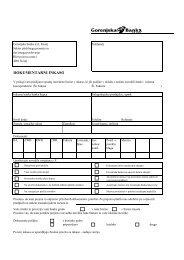Create successful ePaper yourself
Turn your PDF publications into a flip-book with our unique Google optimized e-Paper software.
2.22. Borrowings and other financial liabilities measured at amortized cost<br />
Borrowings are recognised initially at fair value, being their issue proceeds (fair value of consideration<br />
received) net of transaction cost incurred. Borrowings are subsequently stated at amortised cost<br />
and any difference between net proceeds and the redemption value is recognised in the income<br />
statement over the period of the borrowings using the effective interest method.<br />
Other financial liabilities of the bank, measured at amortized cost, are deposits of banks and<br />
customers and debt securities issued.<br />
2.23. Fiduciary activities<br />
The Bank also offers its clients securities intermediation services. A fee is charged for this service.<br />
The clients’ assets are not included in the statement of financial position and do not represent a risk<br />
for the Bank. Details on fiduciary activities are given in note 7.<br />
2.24. Comparatives<br />
Where necessary, comparative figures have been adjusted to conform to changes in presentation<br />
in the current year.<br />
3. Critical accounting estimates and judgments<br />
a) Impairment losses on loans and advances<br />
The Bank reviews its loan portfolio to assess impairment on a monthly basis. In determining whether<br />
an impairment loss should be recorded in the income statement, the Bank makes judgments as to<br />
whether there is any observable data indicating that there is a measurable decrease in the estimated<br />
future cash flows from a portfolio of loans before the decrease can be identified with an individual loan<br />
in that portfolio. This evidence may include observable data indicating that there has been an adverse<br />
change in the payment status of borrowers in a group, or national or local economic conditions that<br />
correlate with defaults on assets in the group. Management uses estimates based on historical loss<br />
experience for assets with credit risk characteristics and objective evidence of impairment similar<br />
to those in the portfolio when scheduling its future cash flows. Individual estimates are based on<br />
future cash flows assessed by accounting officers using all relevant information on counterparty and<br />
its ability to meet specific obligations. Scheduled cash flows are reviewed by independent experts.<br />
Low value exposures are reviewed on the pool basis. The methodology and assumptions used for<br />
estimating both the amount and timing of future cash flows are reviewed regularly to reduce any<br />
differences between loss estimates and actual loss experience.<br />
b) Fair value of financial instruments<br />
The fair values of financial instruments that are not quoted in active markets are determined by<br />
using valuation techniques. Where valuation techniques are used to determine fair values, they are<br />
validated and periodically reviewed by qualified personnel independent of the area that created<br />
them. All models are calibrated to ensure that outputs reflect actual data and cooperative market<br />
prices. To the extent practical, models use only observable data, however areas such as credit risk,<br />
volatilities and correlations require management to make estimates. Changes in assumptions about<br />
these factors could affect reported fair value of financial instruments.<br />
69<br />
<strong>Gorenjska</strong> <strong>banka</strong>, d. d., Kranj<br />
<strong>Annual</strong> <strong>Report</strong> 2011<br />
Financial <strong>Report</strong>



